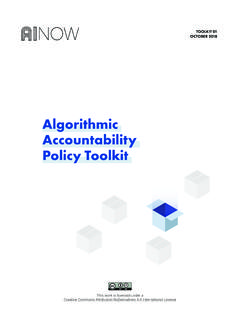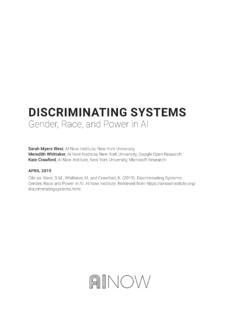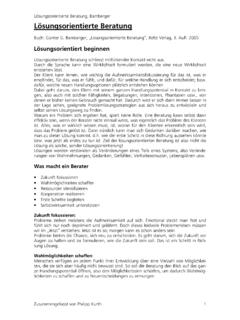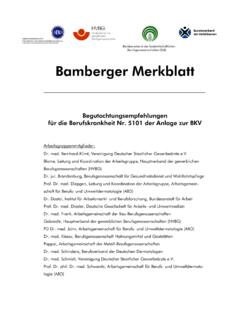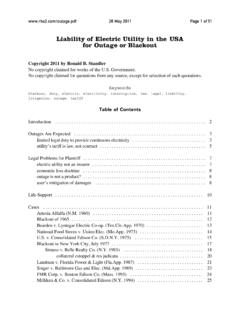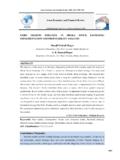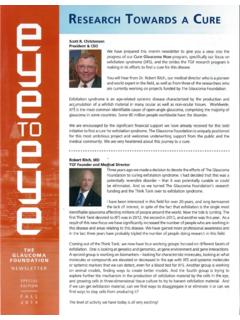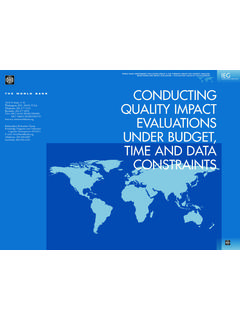Transcription of ALGORITHMIC IMPACT ASSESSMENTS - ainowinstitute.org
1 ALGORITHMIC IMPACT ASSESSMENTS : A PRACTICAL FRAMEWORK FOR PUBLIC AGENCY ACCOUNTABILITYD illon Reisman, Jason Schultz, Kate Crawford, Meredith WhittakerAPRIL 2018 Executive SummaryI. The ALGORITHMIC IMPACT Assessment ProcessA. Pre-acquisition reviewB. Initial agency disclosure requirementsC. Comment periodD. Due process challenge periodE. Renewing AIAsII. The Content of an ALGORITHMIC IMPACT AssessmentA. Establishing Scope: Define automated decision system Challenge: Drawing boundaries around systemsDefinitions and the EU General Data Protection RegulationB. Public notice of existing and proposed automated decision systems: Alert communities about the systems that may affect their livesChallenge: Trade secrecyC. Internal agency self- ASSESSMENTS : Increase the capacity of public agencies to assess fairness, justice, due process, and disparate impactOpportunity: Benefit to vendorsOpportunity: AIAs and public records requestsChallenge: Considering both allocative and representational harmsD.
2 Meaningful access: Allow researchers and auditors to review systems once they are deployedChallenge: Funding and resourcesIII. ConclusionAcknowledgements378 9910101111 13 15 182122 TABLE OF CONTENTSP ublic agencies urgently need a practical framework to assess automated decision systems and to ensure public accountabilityAutomated decision systems are currently being used by public agencies, reshaping how criminal justice systems work via risk assessment algorithms1 and predictive policing,2 optimizing energy use in critical infrastructure through AI-driven resource allocation,3 and changing our employment4 and educational systems through automated evaluation tools5 and matching , advocates, and policymakers are debating when and where automated decision systems are appropriate, including whether they are appropriate at all in particularly sensitive Questions are being raised about how to fully assess the short and long term impacts of these systems.
3 Whose interests they serve, and if they are sufficiently sophisticated to contend with complex social and historical contexts. These questions are essential, and developing strong answers has been hampered in part by a lack of information and access to the systems under deliberation. Many such systems operate as black boxes opaque software tools working outside the scope of meaningful scrutiny and This is concerning, since an informed policy debate is impossible without the ability to understand which existing systems are being used, how they are employed, and whether these systems cause unintended 1 Julia Angwin, Jeff Larson, Surya Mattu and Lauren Kirchner, Machine Bias, ProPublica, May 23, 2016, Jack Smith IV, Crime-prediction tool PredPol amplifies racially biased policing, study shows, Mic, Oct. 9, 2016, #.DZeqQ4 LYs; Andrew G. Ferguson, The Rise of Big Data Policing: Surveillance, Race, and the Future of Law Enforcement, (New York: NYU Press, 2017).
4 3 James Vincent, Google uses DeepMind AI to cut data center energy bills, The Verge, July 21, 2016, Stephen Buranyi, Dehumanising, impenetrable, frustrating : the grim reality of job hunting in the age of AI, The Guardian, March 4, 2018, Laura Moser, A Controversial Teacher-Evaluation Method Is Heading to Court. Here s Why That s a Huge Deal, Slate, Aug. 11, 2015, Benjamin Herold, Custom Software Helps Cities Manage School Choice, Education Week, March 18, 2018, See for example, Kade Crockford, Risk assessment tools in the criminal justice system: inaccurate, unfair, and unjust?, ACLU of Massachusetts, March 8, 2018, ; Virginia Eubanks, Automating Inequality: How High-Tech Tools Profile, Police, and Punish the Poor, (New York: St. Martin s Press, 2018); Nazgol Ghandnoosh, Black Lives Matter: Eliminating Racial Inequity in the Criminal Justice System (Washington DC: The Sentencing Project, 2015), ; Insha Rahman, The State of Bail: A Breakthrough Year for Bail Reform, Vera Institute of Justice, 2017, Frank Pasquale, The Black Box Society: The Secret Algorithms That Control Money and Information (Harvard University Press, 2015).
5 EXECUTIVE SUMMARY3378 9910101111 13 15 182122consequences. The ALGORITHMIC IMPACT Assessment (AIA) framework proposed in this report is designed to support affected communities and stakeholders as they seek to assess the claims made about these systems, and to determine where or if their use is acceptable. It is not simply affected communities who lack the necessary information to assess how automated decision systems are working. Governments themselves are also struggling to assess how these systems are used, whether they are producing disparate impacts, and how to hold them accountable. Currently, few agencies are explicitly mandated to disclose anything about the systems they have in place or are planning to Instead, impacted communities, the public at large, and governments are left to rely on what journalists, researchers, and public records requests have been able to ELEMENTS OF A PUBLIC AGENCY ALGORITHMIC IMPACT ASSESSMENT1.
6 Agencies should conduct a self-assessment of existing and proposed automated decision systems, evaluating potential impacts on fairness, justice, bias, or other concerns across affected communities;2. Agencies should develop meaningful external researcher review processes to discover, measure, or track impacts over time;3. Agencies should provide notice to the public disclosing their definition of automated decision system, existing and proposed systems, and any related self- ASSESSMENTS and researcher review processes before the system has been acquired;4. Agencies should solicit public comments to clarify concerns and answer outstanding questions; and5. Governments should provide enhanced due process mechanisms for affected individuals or communities to challenge inadequate ASSESSMENTS or unfair, biased, or otherwise harmful system uses that agencies have failed to mitigate or governments deploy systems on human populations without frameworks for accountability, they risk losing touch with how decisions have been made, thus making it difficult for them to identify or respond to bias, errors, or other problems.
7 The public will have less insight into how agencies function, and have less power to question or appeal decisions. The urgency of this concern is why the AI Now Institute has called for an end to 9 Catherine Crump, Surveillance Policy Making by Procurement, Wash. L. Rev. 91 (2016): Julia Angwin, et al., Machine Bias ; Ali Winston, Transparency Advocates Win Release of NYPD Predictive Policing Documents, The Intercept, Jan. 27, 2018, SUMMARY4the use of unaudited black box systems in core public The turn to automated decision-making and predictive systems must not prevent agencies from fulfilling their responsibility to protect basic democratic values, such as fairness, justice, and due process, and to guard against threats like illegal discrimination or deprivation of AIAs will help public agencies achieve four key policy goalsAIAs will not solve all of the problems that automated decision systems might raise, but they do provide an important mechanism to inform the public and to engage policymakers and researchers in productive conversation.
8 With this in mind, AIAs are designed to achieve four key policy goals:1. Respect the public s right to know which systems IMPACT their lives by publicly listing and describing automated decision systems that significantly affect individuals and communities;2. Increase public agencies internal expertise and capacity to evaluate the systems they build or procure, so they can anticipate issues that might raise concerns, such as disparate impacts or due process violations;3. Ensure greater accountability of automated decision systems by providing a meaningful and ongoing opportunity for external researchers to review, audit, and assess these systems using methods that allow them to identify and detect problems; and4. Ensure that the public has a meaningful opportunity to respond to and, if necessary, dispute the use of a given system or an agency s approach to ALGORITHMIC IMPACT ASSESSMENTS offer a practical accountability framework combining agency review and public input IMPACT ASSESSMENTS are nothing new.
9 We have seen them implemented in scientific and policy domains as wide-ranging as environmental protection,12 human rights,13 data protection,14 and AIAs draw on these frameworks and combine them with growing and important research that scientific and policy experts have been developing 11 AI Now 2017 Report, Recommendation #1, Leonard Ortolano and Anne Shepard, Environmental IMPACT assessment: challenges and opportunities, IMPACT assessment 13, no. 1 (1995): 3-30. United Nations, Guiding Principles on Business and Human Rights: Implementing the United Nations Protect, Respect and Remedy Framework, 20-24 (2011), Data Protection IMPACT ASSESSMENTS , Information Commissioner s Office, accessed March 16, 2018, Kenneth A. Bamberger and Deirdre Mulligan, Privacy Decision Making in Administrative Agencies, Chicago L. Rev. 75(1):75 (2008), SUMMARY5on the topic of ALGORITHMIC AIAs also complement similar domain-specific proposals for ALGORITHMIC accountability, like Andrew Selbst s recent work on ALGORITHMIC IMPACT Statements in the context of predictive policing By integrating these approaches, AIAs can begin to shed light on automated decision systems, helping us better understand their use and determine where they are and are not appropriate, both before they are deployed and on a recurring basis when they are actively in use.
10 While AIAs will not be a panacea for the problems raised by automated decision systems, they are designed to be practical tools to inform the policy debate about the use of such systems and to provide communities with information that can help determine whether those systems are See generally, Danielle Keats Citron, Technological due process. Wash. L. Rev. 85 (2007): 1249; Lilian Edwards and Michael Veale, Slave to the Algorithm? Why a Right to an Explanation is Probably Not the Remedy You are Looking for, 16 Duke L. & Tech. Rev. 18 (2017); Robert Brauneis and Ellen P. Goodman, ALGORITHMIC transparency for the smart city, 20 Yale J. L. & Tech. 103 (2018); Danielle Keats Citron and Frank Pasquale, The Scored Society: Due process for automated predictions. Wash. L. Rev. 89 (2014): 1; Andrew D. Selbst and Julia Powles, Meaningful information and the right to explanation, International Data Privacy Law 7, no.


